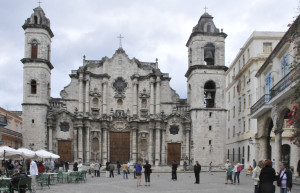
Cathedral of the Virgin Mary of the Immaculate Conception (Photo by Don Knebel)
In the early eighteenth century, Jesuit missionaries sent to Cuba had been so successful converting the indigenous people to Christianity that they received permission in 1727 to build a small church in a former Havana swamp. Work on the church, designed by Francesco Borromini, began in 1748, with the ornate façade constructed from coral blocks taken from nearby Cojimar. In 1767, King Charles III, jealous of the Jesuit’s power, expelled them from Spanish lands, including Cuba. The church was completed without them in 1777 and became a cathedral. The towers flanking the cathedral’s entrance are of noticeably different sizes, following the examples of Gothic architects, such as the ones who deliberately made the portals of Notre Dame Cathedral dissimilar because only God can create perfect symmetry. The bells in the larger tower reportedly include gold and silver along with bronze, giving them an unusually sweet sound. The cathedral itself has been described as “music cast into stone.”
After Columbus died in Spain in 1506, he was buried in Hispaniola, where he had stopped on each of his trips to the New World. When Spain ceded Hispaniola to France in 1795, an urn-full of Columbus’ remains was sent to Cuba, where they were interred in the Havana Cathedral’s Altar of the Gospel. After the Spanish American War, the contents of the urn were reshipped across the Atlantic Ocean and placed in an above-ground tomb in the cathedral in Seville, Spain.
Havana’s Cathedral is the seat of the Archdiocese of San Cristóbal de la Habana. The cathedral and the adjoining car-free Plaza of the Cathedral are popular destinations for American visitors, including President Obama.
Comments are closed.